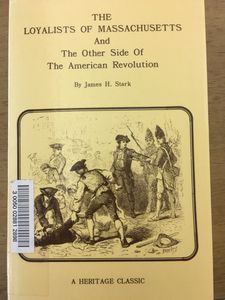The standard work on Massachusetts Loyalists, this book was originally published as a corrective to the then ubiquitous notion that Massachusetts had been a homogeneous bastion of Patriot activity during the Revolution. Mr. Stark dispels this preconception by documenting the trials of Loyalists at various levels of Massachusetts society, such as those of native-born Governor Thomas Hutchinson and John Singleton Copley, the greatest of all 18th-century American painters--both of whom abandoned Massachusetts to live out the balance of their years in exile in Great Britain. While the book's first hundred pages describe general patterns of Loyalism, such as the confiscation of Loyalist property and the Loyalist exodus to Canada accompanying General Gage's withdrawal from Boston, the final 400 pages are chock-full of detailed essays of specific Loyalist families. In the majority of cases the essays sketch out the family history for several generations, the events leading up to the family's (or leading protagonist's) departure from the United States, and some account of the Loyalists' fortunes or whereabouts in the years following the war. At the back of this illustrated volume the reader will find two extremely useful indexes: one to names and the other to subjects.
Following is a partial list of the main families covered by Mr. Stark: Amory, Apthorp, Auchmuty, Barnes, Bernard, Boutineau, Bowes, Brattle, Brinley, Browne, Byles, Caner, Chandler, Chipman, Clark, Clarke, Coffin, Copley, Cunningham, Curwen, Cutler, Deblois, Draper, Erving, Faneuil, Flucker, Frankland, Gardiner, Gay, Geyer, Goldthwaite, Gore, Gray, Hallowell, Harrison, Hatch, Hingham, Hooper, Howe, Hutchinson, Jeffries, Johonnot, Joy, King, Lechmere, Leonard, Lewis, Lillie, Loring, Lyde, Lynde, Malcomb, Marston, Murray, Octherlony, Oliver, Paddock, Pagan, Paine, Paxton, Pepperrell, Phips, Pote, Putnam, Quincy, Richardson, Robie, Royall, Ruggles, Russell, Saltonstall, Sayward, Sewall, Sheaffe,Thompson, Vassall, Walter, Winslow, Winthrop, Wiswell, and Wyer.
